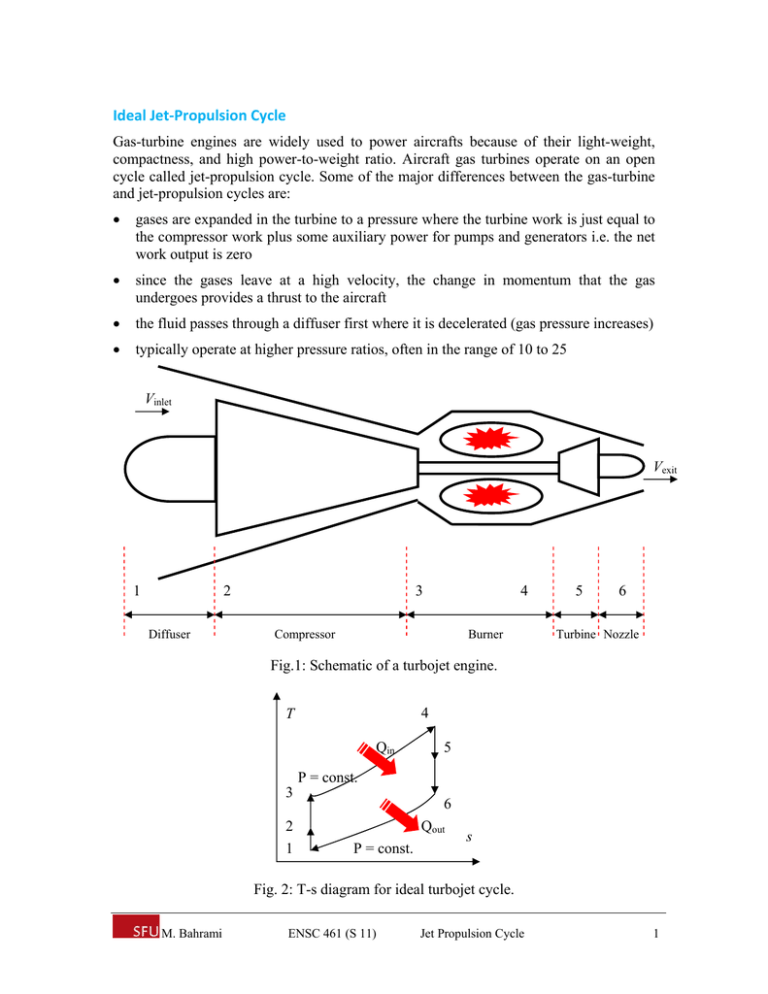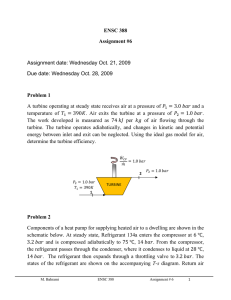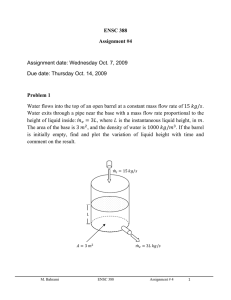Ideal Jet‐Propulsion Cycle
advertisement

Ideal Jet‐Propulsion Cycle Gas-turbine engines are widely used to power aircrafts because of their light-weight, compactness, and high power-to-weight ratio. Aircraft gas turbines operate on an open cycle called jet-propulsion cycle. Some of the major differences between the gas-turbine and jet-propulsion cycles are: gases are expanded in the turbine to a pressure where the turbine work is just equal to the compressor work plus some auxiliary power for pumps and generators i.e. the net work output is zero since the gases leave at a high velocity, the change in momentum that the gas undergoes provides a thrust to the aircraft the fluid passes through a diffuser first where it is decelerated (gas pressure increases) typically operate at higher pressure ratios, often in the range of 10 to 25 Vinlet Vexit 1 2 Diffuser 3 4 Compressor Burner 5 6 Turbine Nozzle Fig.1: Schematic of a turbojet engine. 4 T Qin 3 P = const. 6 2 1 5 Qout P = const. s Fig. 2: T-s diagram for ideal turbojet cycle. M. Bahrami ENSC 461 (S 11) Jet Propulsion Cycle 1 Diffuser (1-2) decelerates the incoming flow relative to the engine a pressure rise known as a ram effect occurs, V (↓), P (↑). It can be explained through the Bernoulli’s equation: P 1 V 2 gh Const. 2 Compressor, Burner and Turbine (2-5) 2-3: isentropic compression 3-4: constant pressure heat addition 4-5: isentropic expansion through the turbine during which work is developed turbine power just enough to drive the compressor air and fuel are mixed and burned in the combustion chamber at constant pressure air velocity leaving the turbine is small and can be neglected Nozzle (5-6) isentropic expansion through the nozzle, air accelerates and the pressure deceases gases leave the turbine significantly higher in pressure than atmospheric pressure gases are expanded to produce a high velocity, Ve >> Vi results in a thrust The pressure at the inlet and the exist of a turbojet engine are identical (the ambient pressure); thus the net thrust developed by the engine is: F mV mV mVexit Vinlet exit inlet N For an aircraft cruising in still air, Vinlet is the aircraft velocity. The power developed from the thrust of the engine is called the propulsive power: WP FVaircraft mVexit Vinlet Vaircraft kW The thermal efficiency is defined based on the propulsive power. This then becomes a measure of how efficiently the energy released during the combustion process is converted to propulsive energy. Propulsive power (Benefit) WP P Input energy (Cost) Qin Afterburner Afterburner is popular in military aircrafts and it is used whenever a need for extra thrust arises, such as for short takeoffs or combat conditions. Afterburner is similar to a reheat device; it is located after the turbine and before the nozzle. It produces a higher M. Bahrami ENSC 461 (S 11) Jet Propulsion Cycle 2 temperature (and pressure) at the nozzle inlet, results in an increase in velocity (and thrust). Qafterburner 4 T 6 Qin 3 5 P = const. 2 1 7 P = const. Qout s Fig. 3: T-s diagram for an ideal turbojet with afterburner cycle. Vinlet Vexit 1 Diffuser 2 3 Compressor Burner 4 5 6 Nozzle 7 Turbine Afterburner Fig. 4: Schematic diagram for a turbojet engine with afterburner. Turboprop gas turbine drives the compressor and the propeller most of the thrust is from the propeller works by accelerating large volumes of air to moderate velocities propellers are best suited for low speed (less than 500 mph) flight by-pass ratio of 100:1 or more Bypass ratio M. Bahrami mass flow bypassing the combustion chamber mass flow through the combustion chamber ENSC 461 (S 11) Jet Propulsion Cycle 3 Turbofan The most popular engine in aircrafts is the turbofan (or fanjet) where fan driven by the turbine forces a considerable amount of air through a duct (cowl) surrounding the engine. best choice for fuel economy and speed high speed exhaust gases are mixed with the lower speed air in the by-pass resulting in a considerable noise reduction by-pass ratio can be adjusted by-pass provides thrust for takeoff the core provides thrust for cruising typically used for speeds up to 600 mph typical by-pass ratios are 5-6 Vinlet Fan exhaust Turbine exhaust Fan Compressor Burner Nozzle Turbine Fig. 5: Schematic of a turbofan engine. Ramjet A ramjet is properly shaped duct with no compressor or turbine. It is used for high-speed propulsion and missiles. Compression is achieved by decelerating the high-speed incoming air in the diffuser aircraft must already be in flight at a high speed. Ramjet is typically used in aircraft flying above Mach 1. M. Bahrami ENSC 461 (S 11) Jet Propulsion Cycle 4 M. Bahrami ENSC 461 (S 11) Jet Propulsion Cycle 5



